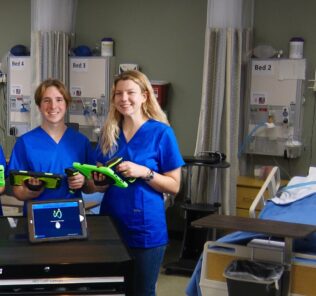Healthcare Simulation Escape Room Tips & Tricks | Part 3
Escape rooms can be a fun, interactive way to promote successful learning outcomes across clinical simulation environments. In this article, author Michelle Sherlin adds to her previous two articles on escape rooms, through which she has shared methods on how to best select bags, boxes, and other kinds of containers in which to place clues. She also touched on how to select locks and fasten them to objects in an escape room, as well as ways for the simulationist to incorporate medical equipment and props as tools. As the third HealthySimulation.com article in this three-part escape room series, Sherlin additionally explores creative puzzles and clue ideas, the use of black lights and mirrors, and how to make and use QR codes.
Making Puzzles and Riddles
Once a theme is determined, the next challenge is to develop meaningful opportunities for learners to utilize previous or newly gained knowledge while traveling through the escape room space. This can be accomplished so many ways, such as through a crossword puzzle, with certain letter spaces highlighted alongside directions that say, “help the patient finish her crossword puzzle.”
Questions in the crossword should be centered around the theme. As learners fill in the blanks, they will discover that the highlighted letters correspond to letters on the lock on the box that the simulationist has set up nearby. Anagrams, cryptograms, and word searches would work also. Discover Education’s Puzzlemaker is a great free resource for making these.
Sponsored Content:
A word of advice: participants will write on documents, even if instructed not to. Place documents inside a plastic page protector. Be sure to staple the protector closed because participants will still access the documents if they are able to. Place scrap paper and pencils or dry-erase markers nearby. This will ensure that educators can reuse the documents without having to make new copies because the document has been written on by participants.
Medication calculations or titration questions easily lend themselves to solving locks that use numbers. Keep calculators with scrap paper and pencils nearby, especially if participants are not allowed to use their phones.
Hiding in Plain Sight
If the healthcare simulationist wants the participants to spend the majority of their time reasoning and problem-solving, and not looking throughout the medical simulation space for a missing clue, it is important to carefully consider where the clues are placed and how visible they are. Another way to make a clue is to cut certain letters out of a magazine cover or newspaper. Leave it in a conspicuous place near a locked box. Place bright-colored paper behind the cut-out spaces to help with visibility. The missing letters could provide a clue or simply be a lock combination. Letters on a keyboard or numbers on a telephone handset could be covered up to provide clues as well.
Sponsored Content:
Further, black light is a fun and easy tool, and educators can purchase handheld black light flashlights online. There are many colors of invisible ink markers available online as well. Some packs also come with key chain-style handheld mini-lights. The larger flashlight style will last longer and not easily get lost like the key chain style, however. Write on something that you don’t mind permanently stained. It does not easily come off. Again, use page protectors or manually laminate the document with self-adhesive laminating sheets if you wish to preserve it. If you wish to write on the walls, use flip chart paper.
Additional Articles:
- Healthcare Simulation Escape Room Tips & Tricks | Part 1
- Healthcare Simulation Escape Room Tips & Tricks Part 2
Mirrors and Magnifying Glasses
Writing a clue entirely backward could require the use of a mirror to reverse the letters to read. Microsoft Word has instructions on how to format text in this way. Some astute participants can read the clue without the mirror, but it takes more time. Place a hand mirror on top of the document that needs to be deciphered so that it is as obvious as possible. Magnifying glasses are often used in escape rooms. Make a clue using tiny lettering, size 8 font or so. Participants will need to use a magnifying glass or a cell phone camera to read the information.
QR Codes
QR codes are a novel way to “hide” additional information for participants. There are several free QR code makers available online. Simply create a document, and upload it to a web repository such as google drive. Create the web link and paste the link into the QR code maker. Cut the QR code out and print it.
A few things to keep in mind. Participants will have to use their cell phone cameras, so be sure it’s allowed. Also pulling up the link can be difficult. Android phones and iPhones differ in how they display information. If participants click on the web link that appears, depending on what kind of device they have, they could be brought to an irrelevant web page. Sometimes no clicking is needed. Test it first yourself with both kinds of devices. Then have students designate one team member, who successfully scans a sample QR code before the activity begins. Also, be sure that the document share settings linked to the QR code will allow participants to view the document. QR codes could be used to provide a web-based resource as well.
Planning the route
One way that helps ensure participants don’t skip ahead and miss essential information that faculty want them to explore is to state where the next clue will be found, within the previous lockbox. A phrase could read something like “great job team, this is the correct dose of insulin, please gather the supplies to administer the dose.” In a home-themed escape room, participants might find the insulin on a bedside table. That location would then naturally be the next step.
Ensuring that Nothing is Missed
Consider purchasing blank, “make-your-own,” jigsaw puzzles. There are many sizes and numbers of pieces to choose from. A 12-piece puzzle is adequate. On the front side of the puzzle, draw or print a theme-related picture. Place one piece inside every locked box. Give one piece as a sample so the participants know what they are looking for. The challenge of collecting every piece to build the puzzle can help ensure that every clue box has been opened.
If multiple groups will be completing the escape room consecutively, color code the back of every piece of one whole jigsaw puzzle with the same color sticker dots, then do the same with a different color set of dots on the back of another puzzle, and so on. Place one piece of each color in every clue box. Instruct teams to collect only the puzzle pieces with their assigned color as they travel through the room. They will know they have “escaped” when they have all of the pieces to their puzzle.
Don’t forget the photo op!
A fun way to end the adventure is to have a large handmade picture frame that exclaims “We escaped!” made from a large piece of festively decorated, foam poster board with a cut-out center. Participants can stand behind it, framing themselves for a fun photo! If timing the teams, have a small whiteboard or chalkboard handy and write the team’s time for them to display as well. Keep in mind that no matter how many times this is run, there will eventually be a group that does not finish in the allotted time. In order to still maintain a happy ending, make a small handheld sign that says “Almost! Next time! We got this!” for the team to hold with the frame.
Learn More Escape Room Tips & Tricks
Disclaimer: Views expressed here are solely those of the author and do not represent those of any employer or organization.
Michelle Sherlin, RN, BSN, CHSE, is the full-time coordinator of the 18-bed simulation lab at the Holyoke Community College Center for Health Education and Simulation. She has patient simulation experience dating back to 2002 when she started healthcare simulation at a vocational school and progressed to implementing simulation activities for several area schools and health care facilities. Her background includes curriculum development at the high school and college levels. Sherlin has hosted patient simulation-related conferences and presented on a multitude of topics. She stays current in nursing practice by working as a staff nurse in the Emergency Department. Sherlin is a per diem educator for the same facility where she conducts patient simulation and teaches Advanced Cardiac Life Support. She also works for a community partnership at another local hospital. In that position, she implements a variety of programs to introduce students to various health care professions. She recently won the “Excellence in Clinical Simulation” award from Education Management Solutions.
Sponsored Content:




















